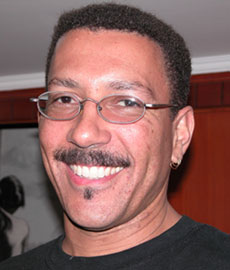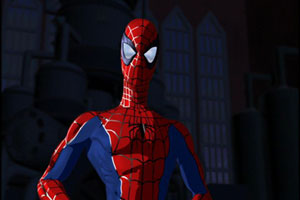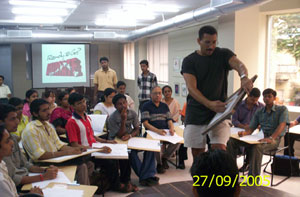 Culture and art have always found a high place in Bengal. Little surprise then, that 2 promising animation schools, earlier Toonzwebel and now the Jindal promoted RTG Animate both have set base in Kolkata.
Culture and art have always found a high place in Bengal. Little surprise then, that 2 promising animation schools, earlier Toonzwebel and now the Jindal promoted RTG Animate both have set base in Kolkata.
Students and aspirants to animation in India are starving for some good animation grounding and education. Inspite of the umpteens of training institutes that have sprouted everywhere, very few really go beyond teaching from software manuals.
Founded by Arjun Jindal and Sudhin Shahani, Ready to go animate the animation school as well as studio hold a lot of promise thanks to the people attached to the project like Dean Vincent Edwards, animation director Dennis Deegan(Former Dean, Toonzwebel) and digital animation director Satya Murthy.
Whether RTG Animate holds true to its promise remains to be seen, but one can optimistically hope that it will.
A telephonic conversation with RTG Animate Dean Vincent Edwards and you guess that besides his professional talents, he seems to have a great sense of humor, second call onwards the hunch is confirmed.
Serious about animation but never low on the fun quotient here are excerpts from an Animation ‘xpress interview with Vincent Edwards.
Please talk about how you got into animation and what has the journey
been like so far?
When I was a kid I wanted to be a comic book artist, so I imitated the artists who’s work I admired. I was fascinated by the idea of telling stories about fantastical people and places. For me the illustrated image was far more powerful when combined with a written narrative than either of them by themselves. UCLA school of Fine Art taught me about the power art has to stir people to a higher level of awareness and compassion, and it was there that I developed a profound ambition. I wanted to find a canvas big enough to paint a picture that could be seen by a lot of people, and I spent years searching for it.
To pay the rent along the way as a professional artist, I found myself working on the fringes of the animation industry-doing digital “ink and paint” and storyboard “cleanup” on television shows back in ’91. One day I realized (like an idiot) that the answer was right in front of me: the canvas that everyone sees is the television and movie screen! Here was the medium where image and story merged in the most dynamic ways possible! That day I began to study in earnest the tradecraft of making motion pictures of all sorts. Live action films, video games, and animation are constantly seen by people everywhere, and the opportunities to create moving art are abundant.
Working in Hollywood you find yourself in competition with extremely talented people who have come from all over the world to work in “THE (entertainment) INDUSTRY”, so the very best artists are often the ones working beside you, and the opportunities to learn on the job are enormous. I have learned far more about the PRACTICAL art of animation while being paid to do so than I ever learned in school. Versatility is one of those things. It important to have a variety of complementary skill sets if you want to keep working!
Another thing is the relationship between ART and COMMERCE. You can never forget that while as an artist you may want to do stuff that’s meaningful and cool, someone is paying the bill for it, and they want a return on their investment. While this may seem to suggest that these two forces are at odds, in fact the opposite is true. There have been films that have fulfilled every AESTHETIC criteria (meaning ‘it looks really cool’) that have failed at the box office because they did not appeal to a wide audience. There have also been films that looked great as a PROJECTED AUDIENCE DEMOGRAPHIC (which is exec-speak for ‘it can’t fail’) but which did fail because they had no ARTISTIC integrity (which is art-speak for ‘it’s a giant commercial’). The truth is, a healthy balance between the two is essential for the success of any entertainment venture, animated or otherwise.
 “A healthy balance between art and commerce is essential for the success of any entertainment venture, animated or otherwise”
“A healthy balance between art and commerce is essential for the success of any entertainment venture, animated or otherwise”
Spiderman TV series:Copyright 2003 Adelaide Productions Inc. All right Reserved. Spiderman Character: TM & Copyright 2003 Marvel Characters Inc.
Animation is my favorite medium. My journey has led me to the point where I really appreciate the plasticity and versatility of animation-you can use it for everything from cel phone graphics to big budget feature films. It transcends cultural boundaries because it can be used to tell stories and convey ideas that are not specific to any one ethnic group or culture. The businessman in me says: “That’s a BIG MARKET!”. And the artist in me says: “That’s a BIG CANVAS!”.
How come India?
Because I don’t speak Chinese. Because my wife likes yoga. Because there are smart people by the busloads who would be earning a comfortable middle class income doing animation if only someone would REALLY show them how. Because I’d like to build a world class animation studio that will employ hundreds of passionate and brilliantly talented artists to make entertainment for both India and the rest of the world. But mostly because I really like chicken tikka.
Of the many current business models prevalent in Indian animation, which one do you think has potential and why?
I like the model where there is a business plan more evolved than “take the money and run”. The future of a strong Indian animation industry requires investors who are willing to look to the long term and not the quick buck; it is not possible to build a stable industry base around a corporate raider mentality. I think that this type of thing has hurt the industry in the recent past with regard to perceptions in the global community.
STEP 1 in considering the Indian Animation Equation is the talent pool. With a few studios as notable exceptions, (and you guys know who you are!) there simply aren’t enough good animators in India today. Perhaps I should say ‘not enough animators capable of achieving a result that is comparable to the global standard’. What I perceive as the ‘global standard’ is simply this: is it good enough to go into syndication on networks all over the world?
Some of the stuff I’ve seen here is OK for local television ads or local market dvds, but it would never stand up to comparison against that standard. So while there are plenty of animators out there, they sadly have not been provided with training to enable that qualitative result. Too many ‘fly-by-night’ operators of so-called ‘animation academies’ have failed to provide the skills required, and when they ‘took the money and ran’ they gave a black eye to the whole animation education industry. Ready To Go Animate Academy is our solution to this aspect of the equation. We must create a class of artisans capable of doing the work that we will undertake in the future.
STEP 2 is the creation of our production studio. This will occur concurrent with the intake of our first batch of students. We are currently in discussions with several Indian animation studios regarding the apprenticeship of our students to them, as well as having them subcontract on work which comes through our agencies. These strategic alliance will not only solidify the domestic industry overall, it will allow us to cultivate a client base that our own students will be hired to service as they graduate. We fully anticipate that in raising the bar on the quality of training, we will be raising the bar on the caliber of work which can be accomplished by studios that are fortunate enough to acquire our graduates.
STEP 3 is where it gets really fun. This is where we grow our studio on outsourced work-for-hire at the same time we develop original content for the domestic market. Wouldn’t it be nice to see a broader range of quality programming aimed specifically at the Indian market?
When was RTG Animate founded and who are the founders?
Ready To Go Animate was dreamed up 4 years back by two business school chums named Arjun Jindal and Sudhin Shahani. As time passed the emerging global landscape began to suggest that perhaps it was more than just a good idea, so they began to cast about for experienced animation professionals to help them put together a good program. When we met and they told me about their ideas I was immediately interested, since I had been listening for some time to animation studio executives in Hollywood going on about how it sure would be great if they could offshore some of the production work to India if only there were more good studios there. So off we went….and a merry ride its been!
 “We must create a class of artisans capable of doing the work that
“We must create a class of artisans capable of doing the work that
we will undertake in the future”
What is the research behind the RTG curriculum and who are the faculty?
Over the last couple of years a lot of comparative research has been done by a lot of people. In my case that meant traveling to many of the best media arts schools in the US and distilling their programs into something I could modify to reflect the actual needs of the professional world. The goal was simple: create a 1-2 year course that will effectively teach the fundamental processes required to get an entry level job in the animation industry. (Actually, not simple in retrospect.) The main thing is that, based on my ‘journey’ the most important learning occurs in the professional arena, so the objective is to get people up to that minimum standard as quickly as possible, because they can sooner be of value and get paid while they learn the more advanced stuff.
We are fortunate to have found the other top-notch faculty members on our team. They are: Denis Deegan/Animation Director, Satya Murthy/Digital Animation Director, and Arnab De/Senior Faculty-drawing and animation instruction. We will be adding more faculty members as our need increases.
When does the studio division take off?
As I said, it’s already happening!
Which animation personalities have had a major influence on you?
Brad Bird is like, the Muhammad Ali of the animation world. I really love both his films, “Iron Giant” and “The Incredibles”. The level of integrity and tradecraft in these works is everything I aspire to do as an animator and storyteller. Maybe one day
Hiyao Miyazaki has created some of the most elegant and magical animation I’ve ever seen. His eye for detail in delicate moments has no peer, and his storytelling chops are classic and timeless. “Kiki’s Delivery Service” and “My Neighbor Totoro” are among my favorite films ever.
Also my good friend and former boss, Audu Paden, who was producer at Sony Television Animation when I was a Storyboard artist and later a Director on “Godzilla: The Animated Series, Roughnecks: The Starship Troopers Chronicles, Heavy Gear, and Spiderman: The Animated Series”. We spent many late nights laboring over animation to make sure it was as good as we could possibly make it. He’s over at Nickelodeon now, and I expect that when we have a first rate studio here he’ll at least return my call, since he knows that I love what he loves: Animation that ROCKS!

